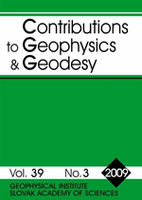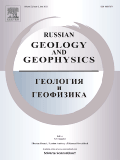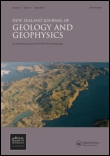
Contributions to Geophysics and Geodesy
Scope & Guideline
Pioneering Research in Earth Sciences Since 1992
Introduction
Aims and Scopes
- Geophysical Methods and Applications:
The journal focuses on the application of diverse geophysical techniques, such as seismic, magnetic, electrical resistivity, and ground penetrating radar, to investigate subsurface structures, mineral resources, and groundwater aquifers. - Climate and Environmental Studies:
Research addressing the impacts of climate variability, including extreme weather events and climate change, is a significant aspect of the journal, highlighting the interaction between geophysical processes and environmental changes. - Geological Investigations:
The journal publishes studies that explore geological formations and their characteristics, including the assessment of hydrocarbon potential and mineralization, thereby contributing to resource management and exploration. - Geodesy and Earth Monitoring:
A core area of the journal is dedicated to geodesy, focusing on Earth's gravitational field, tectonic movements, and land deformation, which are crucial for understanding geophysical processes and natural hazards. - Interdisciplinary Research:
The journal promotes interdisciplinary approaches that combine geophysics with other fields such as hydrology, geology, and environmental science to provide comprehensive insights into complex geophysical issues.
Trending and Emerging
- Integration of Geophysical Techniques:
There is an increasing trend in integrating multiple geophysical methods, such as combining electrical resistivity with electromagnetic methods, to provide a more comprehensive understanding of subsurface features. - Impact of Climate Change:
Research focusing on the implications of climate change on hydrological cycles, extreme weather patterns, and geological processes is gaining prominence, highlighting the urgency of addressing environmental challenges. - Advanced Data Analysis Techniques:
The use of sophisticated data analysis techniques, such as machine learning and enhanced filtering methods in potential field data, is emerging as a significant theme, reflecting advancements in computational geophysics. - Geophysical Monitoring of Natural Hazards:
An increasing number of studies are dedicated to monitoring and assessing natural hazards, such as earthquakes and landslides, through real-time geophysical data collection and analysis, underscoring the importance of disaster preparedness. - Hydrocarbon Exploration Innovations:
Innovative approaches in hydrocarbon exploration, particularly in complex geological settings, are becoming more prevalent, indicating a growing interest in optimizing resource extraction methods.
Declining or Waning
- Traditional Seismology:
There is a noticeable decrease in the frequency of papers solely focused on traditional seismic studies, possibly due to a growing preference for integrated approaches that combine multiple geophysical methods. - Static Geophysical Measurements:
Research centered exclusively on static measurements, such as gravity and magnetic studies without dynamic interpretations, has diminished, indicating a shift towards more dynamic and real-time monitoring techniques. - Historical Geophysical Studies:
Papers focusing on historical data analysis or retrospectives on past geophysical events are becoming less common, suggesting a trend towards contemporary and predictive analyses rather than historical assessments. - Geophysical Education and Methodology:
There appears to be a reduction in articles discussing educational methodologies in geophysics, indicating that the focus may be shifting towards applied research and technical advancements rather than pedagogical approaches.
Similar Journals

Journal of Himalayan Earth Sciences
Advancing Knowledge in Himalayan Earth SciencesThe Journal of Himalayan Earth Sciences (ISSN: 1994-3237; E-ISSN: 2305-6959) is a distinguished publication by UNIV PESHAWAR, dedicated to advancing knowledge in the field of earth sciences, particularly as they relate to the Himalayan region. Established in 2013, this journal aims to provide a platform for researchers, professionals, and students to share original research findings, reviews, and innovative methodologies that contribute to the understanding of geological and environmental phenomena in this ecologically significant area. Despite being categorized in Q4 of the Earth and Planetary Sciences, the journal showcases valuable contributions to the scientific community and encourages submissions that delve into both the challenges and advancements within Earth sciences, with a particular focus on the unique geological structures and processes of the Himalayas. As an open-access journal, it ensures that research is accessible to a global readership, promoting collaboration and discussion among scholars and practitioners. The journal's operational base in Peshawar, Pakistan, places it at the heart of Himalayan research, making it an invaluable resource for those invested in earth sciences.

Geodesy and Geodynamics
Connecting Disciplines to Illuminate Planetary Sciences.Geodesy and Geodynamics is a premier open-access journal dedicated to the interdisciplinary fields of geodesy and geodynamics, published by KEAI PUBLISHING LTD. With a commitment to accessibility since 2010, this journal serves as an essential platform for researchers, professionals, and students in understanding the Earth's structure, dynamics, and geophysical processes. Based in China, it has rapidly gained recognition, earning a commendable Q2 ranking in various categories, including Computers in Earth Sciences, Earth-Surface Processes, and Geophysics. The journal covers critical advances in theory and practice, making significant contributions to the study of planetary sciences. Researchers can benefit from a robust readership and impactful dissemination of their work, as evidenced by its solid positions in Scopus rankings. Moving forward, Geodesy and Geodynamics aims to continue fostering innovation and collaboration within the geoscience community through high-quality research and comprehensive review articles.

DOKLADY EARTH SCIENCES
Unveiling Insights into Our Planet's DynamicsDOKLADY EARTH SCIENCES is a reputable journal published by MAIK NAUKA/INTERPERIODICA/SPRINGER, focusing on the dynamic field of Earth and Planetary Sciences. With an ISSN of 1028-334X and E-ISSN 1531-8354, this journal offers a platform for researchers to disseminate their findings and insights that contribute to our understanding of Earth systems over a continuous publishing span from 1998 to 2024. It currently holds a Q3 quartile ranking in the Earth and Planetary Sciences category, reflecting an emerging yet significant impact within its field, evidenced by its Scopus ranks where it stands at 123rd in general Earth sciences and 113th in miscellaneous Earth sciences. DOKLADY EARTH SCIENCES aims to bridge research gaps and foster collaboration among a diverse audience including researchers, professionals, and students committed to advancing knowledge in geoscience. The journal stands as a vital resource for those seeking to explore contemporary challenges and innovations within the realm of Earth sciences.

Russian Geology and Geophysics
Connecting Knowledge and Innovation in Earth SciencesRussian Geology and Geophysics is a seminal journal published by GEOSCIENCEWORLD that plays a pivotal role in the dissemination of vital research within the realms of Earth-Surface Processes, Geology, and Geophysics. With an ISSN of 1068-7971 and an E-ISSN of 1878-030X, this journal has witnessed a continuous evolution since its convergence in 2007 and is poised to thrive through 2024. While it is not an Open Access journal, it is recognized for its significant contributions to the academic community, holding a respectable Q2 ranking in Earth-Surface Processes and Q3 rankings in both Geology and Geophysics as of 2023. The journal’s impact factors align it within competitive quartiles, marking it as an essential resource for researchers and professionals seeking to stay at the forefront of geological and geophysical sciences. By publishing high-quality peer-reviewed articles, the journal fosters an environment of knowledge sharing and innovation, making it indispensable for students, practitioners, and scholars alike who are dedicated to advancing our understanding of Earth's complex systems.

STUDIA GEOPHYSICA ET GEODAETICA
Connecting Scholars in the Realm of Earth SciencesSTUDIA GEOPHYSICA ET GEODAETICA, published by Springer, is a prestigious scientific journal that has been at the forefront of the fields of Geochemistry, Petrology, and Geophysics since its inception in 1957. With an ISSN of 0039-3169 and an E-ISSN of 1573-1626, the journal serves as a vital platform for disseminating original research and reviews that enhance our understanding of the Earth’s processes. Situated in the Netherlands, the journal is indexed in notable databases, holding a respectable Tier Q3 ranking in both Geochemistry and Petrology, as well as Geophysics, based on the 2023 metrics. With its commitment to academic rigor, the journal seeks to engage a diverse audience of researchers, professionals, and students, facilitating vital discourse and advancements in Earth sciences. Although it does not currently offer open access options, it remains a significant resource for those aiming to contribute to or further their knowledge within these critical disciplines.

Geophysics
Connecting Science and Exploration for a Deeper UnderstandingGeophysics, published by the SOC EXPLORATION GEOPHYSICISTS - SEG, is a prestigious journal notable for its significant contributions to the fields of geophysics, geochemistry, and petrology. Since its inception in 1936, this journal has consistently provided a platform for high-quality research, maintaining a strong impact within the academic community, evidenced by its Q1 ranking in these important scientific categories for 2023. With an ISSN of 0016-8033 and an e-ISSN of 1942-2156, it features rigorous peer-reviewed articles that address the latest advancements in geophysics and related disciplines, contributing to a deeper understanding of Earth processes. Although it does not offer open access options, the journal ensures broad dissemination of knowledge and remains essential for researchers, professionals, and students dedicated to exploring energy resources and geophysical phenomena. Its Scopus rankings, including a commendable 22nd out of 165 in Earth and Planetary Sciences for Geophysics, affirm its importance and reach in the academic community. In addition to fostering scholarly discourse, Geophysics plays a critical role in advancing the practical applications of geophysical research, making it a vital resource for those engaged in exploration and environmental studies.

Journal of Indian Geophysical Union
Fostering Collaboration in Geophysical DiscoveriesThe Journal of Indian Geophysical Union, published by the Indian Geophysical Union (IGU), serves as a vital platform for disseminating research in the field of geophysics. With the ISSN 0257-7968, this journal primarily focuses on studies related to geophysical sciences, including but not limited to, seismicity, environmental geophysics, and geodynamics, contributing to a better understanding of the Earth's processes. The journal is committed to quality research and aims to foster a collaborative environment for researchers, professionals, and students in India and internationally. Although currently not designated as an Open Access publication, it plays an essential role in connecting academia with practical applications in geophysical research. Based in Hyderabad, India, the Journal of Indian Geophysical Union continues to be an essential resource for those seeking to expand their knowledge and engage with the latest findings in geophysics.

PURE AND APPLIED GEOPHYSICS
Fostering Cross-Disciplinary Dialogue in Earth SciencesPure and Applied Geophysics, published by Springer Basel AG, is a leading international journal in the fields of Geochemistry and Petrology as well as Geophysics, recognized for its significant contributions to advancing our understanding of the Earth's processes. With an impact factor that positions it in the Q2 category of both specialties, this journal is highly regarded within the scientific community, holding a commendable Scopus ranking of 49 out of 165 in Geophysics and 58 out of 154 in Geochemistry and Petrology. Established in 1964 and continuing to offer valuable research until 2024, it plays a crucial role in disseminating high-quality research findings and methodologies. Scholars and professionals can look forward to a diverse range of articles that cover fundamental and applied aspects, encouraging cross-disciplinary dialogue. Although it does not currently offer open access options, readers can access its wealth of knowledge through institutional subscriptions, making it an essential resource for those engaged in Earth sciences research.

Solid Earth Sciences
Advancing our understanding of Earth's hidden depths.Solid Earth Sciences is a dynamic open-access journal published by Elsevier, dedicated to advancing our understanding of the Earth's subsurface processes and materials. Since its inception in 2016, the journal has established itself as a vital resource for researchers and professionals in the fields of geochemistry, petrology, geology, geophysics, and geotechnical engineering, achieving a notable Q2 ranking in multiple categories as of 2023. With an ISSN of 2451-912X, the journal aims to disseminate high-quality research that enhances knowledge of earth surface processes and the intricate interactions within our planet's systems. The journal is indexed in Scopus, showcasing an impressive rank in various sub-disciplines, with a rank of #96 in Geology and a noteworthy percentile in Earth and Planetary Sciences. Solid Earth Sciences offers a platform for innovative studies, comprehensive methodologies, and cutting-edge technological advancements that cater to a global audience of scientists, academics, and students. With its commitment to open access, it fosters wider dissemination and impact of research outcomes, ensuring that pivotal discoveries reach stakeholders and contribute to real-world applications.

NEW ZEALAND JOURNAL OF GEOLOGY AND GEOPHYSICS
Deepening Understanding of Earth's Dynamic Systems.NEW ZEALAND JOURNAL OF GEOLOGY AND GEOPHYSICS, published by Taylor & Francis Ltd, stands as a prominent forum dedicated to the interdisciplinary exploration of geological and geophysical phenomena. With an impact factor that situates this journal in the prestigious Q1 category across key subjects—namely Earth and Planetary Sciences, Geology, and Geophysics—it is a critical resource for researchers, professionals, and students alike. The journal has been operational since 1958 and continues to contribute valuable insights into the complexities of the Earth's processes. Although it does not currently offer Open Access options, its broad readership benefits from an extensive archive of high-quality research findings that span from 1958 to 2024. Located in the United Kingdom, the journal remains a pivotal player in advancing the understanding of Earth's systems, making significant contributions to both academic inquiry and practical applications in the field.